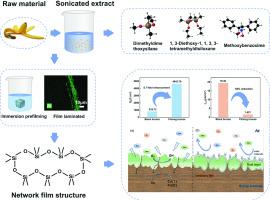The non-destructive sealing and protection of bronze by hydrophobic films with a Si-O-Si network structure
IF 9.2
2区 工程技术
Q1 ENERGY & FUELS
引用次数: 0
Abstract
The conservation of excavated bronze artifacts faces persistent challenges in achieving effective yet nondestructive protection. Conventional protective materials frequently encounter limitations due to environmental toxicity, complicated synthesis processes, and demanding implementation conditions. This study presents an eco-friendly solution through ultrasonic-assisted extraction of banana peel to produce a green corrosion inhibitor (BNA). Electrochemical evaluation on simulated bronze revealed remarkable performance under optimal conditions (298 K, 1 h pretreatment), exhibiting: 5.7-fold enhancement in polarization resistance (from 810.72 to 4642.79 Ω·cm2), 92 % reduction in corrosion current density (19.46 to 1.621 μA/cm2), Maximum inhibition efficiency of 91.69 %. Multi-technique characterization (SEM-EDS/XRD/FT-IR/XPS/Raman/contact angle) demonstrated that silicon-containing organic compounds in BNA form a protective Si-O-Si/O-Si-O network via physicochemical adsorption. This hydrophobic film: 1. Creates an effective diffusion barrier against corrosive species; 2. Inhibits copper oxidation reactions; 3. Maintains artifact integrity without altering patina composition. Notably, BNA penetrates corrosion layers while preserving their original morphology and chemical characteristics, fulfilling essential requirements for archaeological conservation. The developed inhibitor combines environmental sustainability with practical application advantages, offering a promising solution for cultural heritage preservation.

Si-O-Si网络结构疏水膜对青铜的无损密封与保护
对出土青铜器进行有效而无损的保护面临着长期的挑战。由于环境毒性、复杂的合成工艺和苛刻的实施条件,传统的防护材料经常受到限制。本研究采用超声波辅助提取香蕉皮制备绿色缓蚀剂(BNA)。电化学评价表明,在最佳条件下(298 K,预处理1 h),模拟青铜的极化电阻提高了5.7倍(从810.72提高到4642.79 Ω·cm2),腐蚀电流密度降低了92%(从19.46降低到1.621 μA/cm2),最大缓蚀效率为91.69%。多技术表征(SEM-EDS/XRD/FT-IR/XPS/Raman/接触角)表明,BNA中的含硅有机化合物通过物理化学吸附形成保护性的Si-O-Si/O-Si-O网络。这种疏水性薄膜:对腐蚀性物质形成有效的扩散屏障;2. 抑制铜氧化反应;3. 在不改变铜绿成分的情况下保持工件的完整性。值得注意的是,BNA可以穿透腐蚀层,同时保持其原始形态和化学特征,满足考古保护的基本要求。所开发的抑制剂将环境可持续性与实际应用优势相结合,为文化遗产保护提供了一个有前景的解决方案。
本文章由计算机程序翻译,如有差异,请以英文原文为准。
求助全文
约1分钟内获得全文
求助全文
来源期刊

Sustainable Materials and Technologies
Energy-Renewable Energy, Sustainability and the Environment
CiteScore
13.40
自引率
4.20%
发文量
158
审稿时长
45 days
期刊介绍:
Sustainable Materials and Technologies (SM&T), an international, cross-disciplinary, fully open access journal published by Elsevier, focuses on original full-length research articles and reviews. It covers applied or fundamental science of nano-, micro-, meso-, and macro-scale aspects of materials and technologies for sustainable development. SM&T gives special attention to contributions that bridge the knowledge gap between materials and system designs.
 求助内容:
求助内容: 应助结果提醒方式:
应助结果提醒方式:


